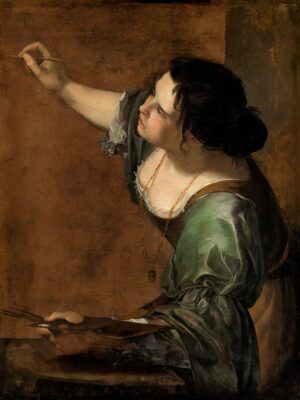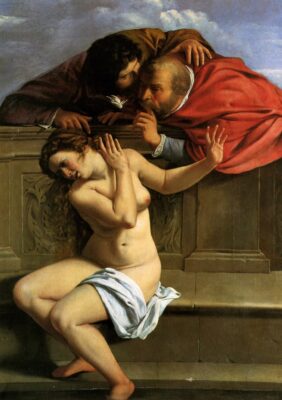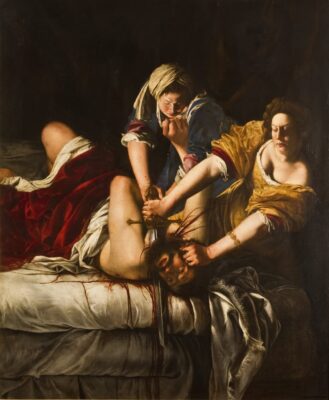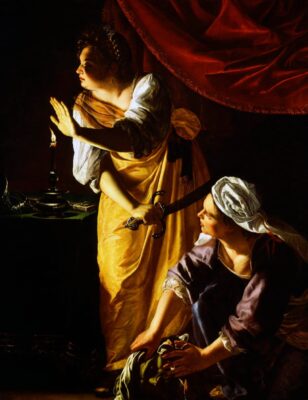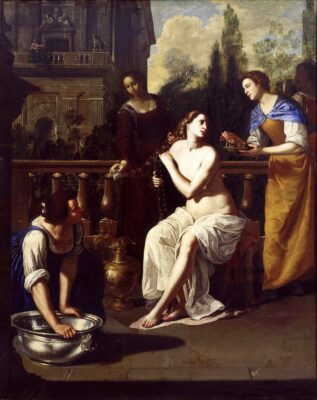Artemisia Gentileschi
Durante las últimas décadas, la admiración hacia la figura de Artemisia Gentileschi ha aumentado como la de ningún otro pintor (en este caso pintora) anterior a la modernidad. En ocasiones, parece como que en dicha admiración se esconde una cierta condescendencia, que hace sospechar que este interés está únicamente provocado por las injusticias (e incluso un caso de violación) que Gentileschi tuvo que soportar durante su vida, cuando, en realidad, el simple estudio de su obra, sin ni siquiera conocer las dificultades que la artista hubo de soportar, es suficiente para colocar a la pintora entre las más importantes figuras de la pintura barroca, y señalarla como la más original de los Caravaggisti.
Imagen: Artemisia Gentileschi: “Autorretrato como alegoría de la pintura”, c.1638-39. Óleo sobre lienzo, Royal Collection, Londres.
Artemisia Gentileschi nació en Roma en 1593, hija del también importante pintor Orazio Gentileschi. Su talentó afloró pronto, y antes de cumplir los dieciocho años pintó una obra notable, “Susana y los viejos”, en la que Susana es acosada por dos ancianos. En esta obra de juventud, «la actitud de Susana, su situación, su estado interior, son los que dominan la atmósfera» (Francisca Pérez Carreño, «Artemisia Gentileschi», 1993). La obra es interesante por su calidad (impropia de una artista tan joven) y por su temática, que parece presagiar el episodio traumático que la autora viviría al año siguiente.
En 1611, Gentileschi fue violada por su tutor personal (ya que la mujeres tenían prohibido el acceso a la Academia), Agostino Tassi. Los detalles de este hecho y del terrible juicio que prosiguió son ya conocidos, así como la ridícula condena (un año de prisión) impuesta a Tassi. Al año siguiente, Gentileschi pintó “Judit decapitando a Holofernes”, a veces interpretada como un anhelo de venganza hacia su violador. Sea como fuera, esta pintura muestra un considerable avance en la técnica de la artista con respecto a su ya notable “Susana y los viejos”.
Artemisia Gentileschi: “Susana y los viejos”, c.1610. Óleo sobre lienzo, 170 × 119 cm. Schönborn, Pommersfelden ·· Artemisia Gentileschi: “Judit decapitando a Holofernes”, 1612-13. Óleo sobre lienzo, 199 × 162.5 cm Museo di Capodimonte, Nápoles.
Ese mismo año, Artemisia Gentileschi contrajo matrimonio con Pierantonio de Vincenzo Stiattesi, y la pareja se mudó a Florencia, donde Gentileschi fue la primera pintora en ingresar en la Academia del Dibujo. Tras su paso por la academia su fama en Florencia aumenta, y recibe encargos de cierta relevancia, entre ellos de la todavía poderosa familia Médici. No obstante, rumores sobre su vida privada, y el fallecimiento de su hijo Cristofano hicieron que se separase de su marido y decidiera volver a Roma en 1620.
En Roma, Gentileschi gozaba de buena reputación entre varios coleccionistas, y durante su estancia en la capital pintó algunas de sus mejores obras, entre ellas “Judit y su doncella”, quizás su obra maestra, y una de las cumbres de la pintura barroca italiana. Sin embargo, no llegó a lograr encargos de relevancia, como grandes retablos. Quizás por ello, en 1627 viaja a Venecia, y tres años más tarde a Nápoles, donde logra sus primeros encargos de verdadera importancia, una gran “Anunciación” conservada hoy en el Museo di Capodimonte, y “Nacimiento de San Juan Bautista”, encargado por el virrey de Nápoles para el Palacio del Buen Retiro de Madrid, y conservado hoy en el Museo del Prado.
Artemisia Gentileschi: “Bathsheba”, c.1636-37. Óleo sobre lienzo, 265.4 x 209.5 cm. Columbus Museum of Art ·· Artemisia Gentileschi: “Judit y su doncella”, 1625-27. Óleo sobre lienzo, 182,2 × 142,2 cm. Detroit Institute of Arts.
Ya en 1626, Orazio Gentileschi, padre de Artemisia, se había establecido en Inglaterra, invitado por el Duque de Buckingham. Artemisia se reunió con su padre en Londres en 1639, donde el propio rey Carlos I se siente atraído por las obras de la pintora, como su “Autorretrato como alegoría de la pintura”. No obstante, poco tiempo después de la muerte de Orazio ese mismo año, Artemisia regresa a Nápoles, donde reside hasta su muerte en 1656.
Artemisia Gentileschi es especialmente famosa por sus pinturas mitológicas y religiosas, mientras que su faceta como retratista permanece algo más desconocida. Con el motivo de la subasta de un hasta entonces desconocido retrato de caballero (posiblemente Antoine de Ville), Sotheby’s explicó en el catálogo de la obra: “Como sólo se conserva un retrato, los historiadores del arte creían anteriormente que estas referencias eran pruebas de escritores masculinos que jugaban con la suposición de que las artistas femeninas se veían obligadas a especializarse en el retrato al no poder estudiar el desnudo masculino, considerado un requisito para la pintura de historia. Ahora que han aparecido tres retratos, las fuentes históricas se ven respaldadas, y es posible que aún aparezcan más retratos que confirmen la maestría de Artemisia en el género.”
G. Fernández · theartwolf.com
Follow us on:

